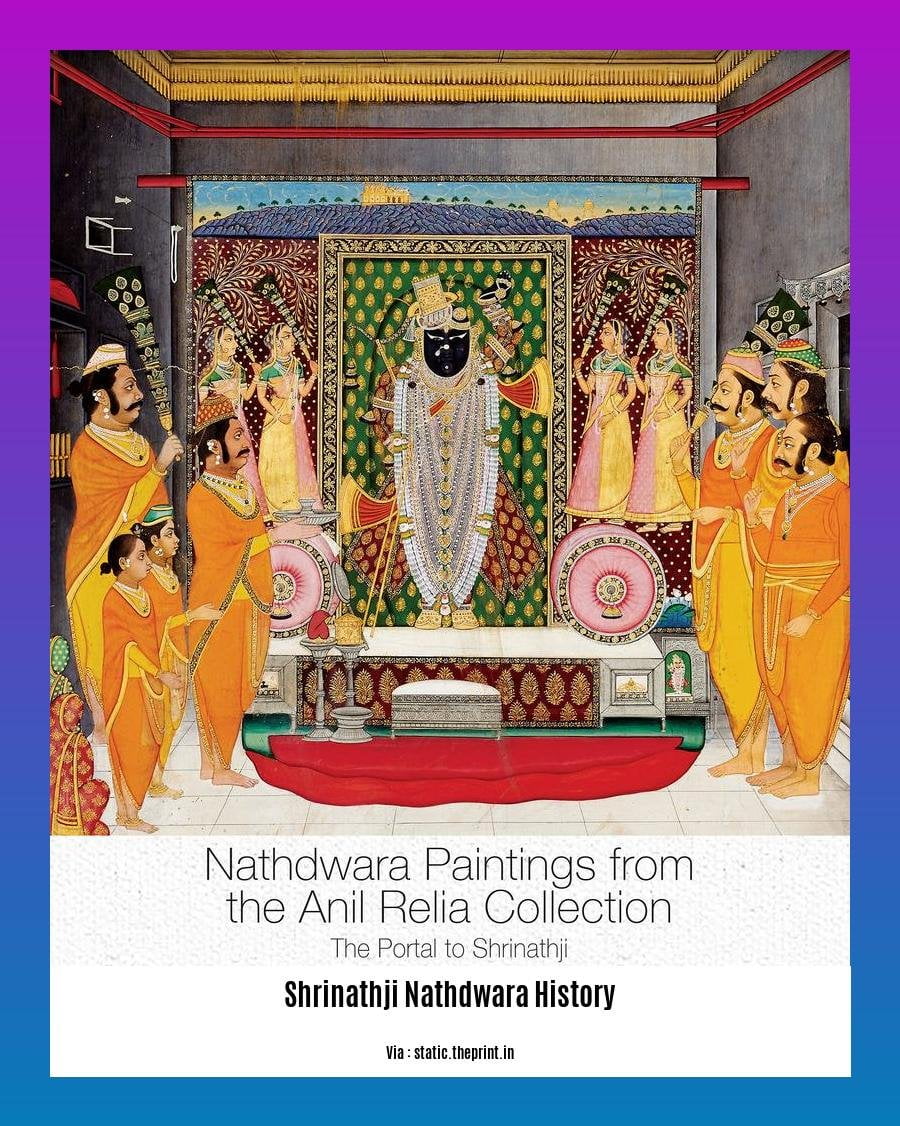– The History of Shrinathji Nathdwara: Unveiling the Divine Legacy – Embark on a captivating journey through the annals of religious history as we delve into the rich tapestry of Shrinathji Nathdwara, an iconic deity whose legend has captivated hearts and souls for centuries.
Key Takeaways:
The Shrinathji Temple in Nathdwara, Rajasthan, India, is devoted to Lord Krishna, revered as Shrinathji.
The temple’s origins date back to the 17th century when the idol of Shrinathji was relocated from Govardhan Hill near Mathura to Nathdwara during the reign of Maharana Raj Singh of Mewar.
The temple is devoted to Lord Krishna in his child form as Shrinathji, a manifestation of Lord Krishna as a seven-year-old child.
Nathdwara city is often referred to as ‘Shrinathji’ due to the prevalence of Shrinathji.
Shrinathji Nathdwara History: A Divine Legacy

In the vibrant land of Rajasthan, India, nestled in the heart of the picturesque town of Nathdwara, lies a sacred temple dedicated to Lord Shrinathji, a revered form of Lord Krishna. Immerse yourself in the captivating history of this divine deity and the iconic temple that bears his name, as we unravel the rich tapestry of devotion woven around Shrinathji for centuries.
A Journey of Faith and Divinity
The story of Shrinathji Nathdwara begins in the ancient city of Mathura, where Lord Krishna spent his early life. Legends narrate that a revered saint, Sri Vallabhacharya, discovered a miraculous idol of the young Krishna, known as Shrinathji, on Govardhan Hill. This divine image, carved from a sacred black stone, depicted Lord Krishna as a seven-year-old child, holding a flute and adorned with exquisite jewels.
The Miraculous Relocation
In the 17th century, during the reign of the valiant Maharana Raj Singh of Mewar, a dark cloud of religious persecution loomed over the land. To protect the sacred idol of Shrinathji from impending threats, a group of devoted followers embarked on a daring journey to relocate the deity to a safer haven.
Finding Refuge in Nathdwara
Guided by divine providence, the devotees found refuge in the serene town of Nathdwara, nestled amidst the majestic Aravalli Hills. Here, they established a magnificent temple dedicated to Shrinathji, where the precious idol was enshrined with utmost reverence and devotion.
A Legacy of Devotion
Over the centuries, the temple of Shrinathji Nathdwara has become a beacon of faith and spirituality, attracting millions of devotees from all corners of the world. The town of Nathdwara itself has transformed into a vibrant center of pilgrimage, with the name ‘Shrinathji’ becoming synonymous with the divine presence that resides within its sacred walls.
The Divine Abode of Shrinathji
The Shrinathji Temple stands as a testament to the enduring legacy of faith and devotion. Its intricate architecture, adorned with intricate carvings and vibrant colors, reflects the grandeur of the deity it houses. The temple’s sanctum sanctorum, where the idol of Shrinathji resides, is a place of profound spiritual energy, where devotees experience a mystical connection with the divine.
A Living Tradition of Worship
The worship of Shrinathji in Nathdwara follows a unique tradition known as Pushti Marg, founded by Sri Vallabhacharya. This tradition emphasizes the importance of love, devotion, and surrender to the divine. The daily rituals performed in the temple, including elaborate aartis, melodious bhajans, and ceremonial offerings, are a testament to the unwavering faith and dedication of the devotees.
Shrinathji: The Beloved Deity
Devotees of Shrinathji revere him as a compassionate and benevolent deity, a playful child who captivates hearts with his enchanting smile and mischievous ways. His divine form, adorned with exquisite jewels and colorful attire, reflects his playful nature and his love for beauty and aesthetics.
A Timeless Pilgrimage
For centuries, pilgrims from far and wide have flocked to Nathdwara to seek blessings from Shrinathji. The temple’s sacred precincts resonate with the chanting of mantras, the tinkling of bells, and the heartfelt prayers of devotees, creating a spiritual atmosphere that is both awe-inspiring and transformative.
Nathdwara: A Divine Destination
The town of Nathdwara has evolved into a vibrant center of pilgrimage, with a thriving community of artisans, craftsmen, and merchants who cater to the needs of the countless devotees who visit the temple. The town’s streets are lined with shops selling religious artifacts, souvenirs, and traditional Rajasthani delicacies, creating a vibrant and colorful tapestry of faith and commerce.
The Enduring Legacy of Shrinathji Nathdwara
The Shrinathji Nathdwara legend is a testament to the enduring power of faith and devotion. It is a story of divine protection, miraculous journeys, and the unwavering belief in the power of the divine to transform lives and bring solace to the hearts of believers. The legacy of Shrinathji Nathdwara continues to inspire and uplift countless souls, serving as a beacon of hope and spirituality for generations to come.
Curious about the rich tapestry of North Cyprus’s past? Delve into our comprehensive guide on North Cyprus history to discover the fascinating events that shaped this captivating island.
Unravel the intriguing tale of Russia’s past through our in-depth analysis of Russia history results. Explore the pivotal moments and key figures that have shaped the course of this vast nation’s destiny.
The Departure from Mathura: The Epic Journey to Nathdwara

The story of Shrinathji’s departure from Mathura and his subsequent journey to Nathdwara is a captivating tale of devotion, divine intervention, and the unwavering faith of his followers.
In the 17th century, when the Mughal emperor Aurangzeb’s religious intolerance threatened the sacred Hindu temples of Mathura, a group of devout Vaishnavites decided to relocate the revered idol of Shrinathji to a safer haven.
Led by the temple priest Damodar Das, a small group of devotees embarked on a perilous journey, carrying the idol of Shrinathji on their shoulders. They faced numerous challenges along the way, braving treacherous terrain, inclement weather, and the constant fear of being discovered by Mughal soldiers.
As the group neared the village of Sihad, now known as Nathdwara, they were met with a divine sign. A cow stopped in its tracks and refused to move, indicating that this was the place where Shrinathji wished to reside. The devotees took this as a clear indication of divine guidance and decided to settle in Sihad.
The journey from Mathura to Nathdwara was not just a physical relocation; it was a spiritual odyssey that tested the faith and devotion of the devotees. Their unwavering belief in Shrinathji’s divine protection and guidance sustained them throughout their arduous journey.
Today, the town of Nathdwara stands as a testament to the enduring legacy of Shrinathji and the remarkable journey that brought him to this sacred abode. Millions of devotees flock to Nathdwara each year, seeking blessings from the beloved deity and reliving the epic tale of his departure from Mathura.
Key Takeaways:
- The decision to relocate Shrinathji from Mathura was driven by the need to protect the idol from Mughal emperor Aurangzeb’s religious persecution.
- The journey from Mathura to Nathdwara was fraught with challenges, including treacherous terrain, inclement weather, and the fear of being discovered by Mughal soldiers.
- A divine sign in the form of a cow that refused to move indicated that Shrinathji wished to reside in Sihad, now known as Nathdwara.
- The journey from Mathura to Nathdwara was a spiritual odyssey that tested the faith and devotion of the devotees.
- Today, Nathdwara stands as a testament to the enduring legacy of Shrinathji and the remarkable journey that brought him to this sacred abode.
Relevant Sources:
- Shrinathji Temple, Nathdwara
- Nathdwara – A Town That Revolves Around Shrinathji
The Grand Consecration: Foundation of the Nathdwara Temple
The Grand Consecration of the Nathdwara Temple stands as a testament to the enduring faith and devotion of Vaishnavas. In 1672, guided by divine visions, Shri Gokulnathji, a revered spiritual leader, embarked on a journey to consecrate the sacred image of Shrinathji in a grand new temple. With the support of dedicated devotees, he laid the foundation of what would become a significant pilgrimage site for Vaishnavites worldwide.
The consecration ceremony was a momentous occasion, marked by elaborate rituals, chanting of Vedic hymns, and the offering of prayers. As the sacred image was installed in the sanctum sanctorum, a divine aura enveloped the temple, infusing it with a sense of holiness.
The Nathdwara Temple’s architecture is a blend of traditional Hindu temple design and the grandeur of Rajput architecture. The temple complex consists of several buildings, including the main shrine, a courtyard, a hall for congregational prayers, and accommodations for pilgrims. The temple’s exterior is adorned with intricate carvings, colorful paintings, and decorative elements that add to its visual splendor.
Inside the temple, the atmosphere is one of reverence and devotion. The sanctum sanctorum houses the black marble image of Shrinathji, which is believed to have manifested from Govardhan Hill. The deity is adorned with exquisite jewelry, garlands, and a vibrant turban, reflecting the love and devotion of the devotees.
Over the centuries, the Nathdwara Temple has undergone several renovations and expansions, but its sanctity and significance have remained intact. It has become a prominent center for Vaishnavite worship, attracting pilgrims from all corners of India and beyond.
Key Takeaways:
- The Nathdwara Temple is dedicated to Shrinathji, a form of Lord Krishna.
- The temple was established in 1672 by Shri Gokulnathji to protect the sacred image of Shrinathji from religious persecution.
- The Grand Consecration ceremony was a significant event that marked the formal establishment of the temple.
- The temple’s architecture is a blend of traditional Hindu temple design and the grandeur of Rajput architecture.
- The Nathdwara Temple has become a prominent center for Vaishnavite worship, attracting pilgrims from all over the world.
Relevant Sources:
- Shrinathji Temple, Nathdwara
- History of Shrinathji Temple, Nathdwara
The Enduring Legacy: Shrinathji as the Beloved Deity of Vallabha Sampradaya
In a world captivated by larger-than-life deities, there exists a divine entity that holds an enduring legacy in the hearts of Hindu Vaishnavas—Shrinathji, the beloved deity of the Vallabha Sampradaya.
Delve into the sacred journey of this revered form of Lord Krishna, whose story is intricately interwoven with the history of the Vallabha Sampradaya, a spiritual lineage founded by the revered saint, Vallabhācārya.
Embark on a pilgrimage through time, where we unravel the legend of Shrinathji, his profound teachings, and the magnificent temple that serves as the epicenter of his worship, the Shrinathji Temple in Nathdwara.
The Manifestation of Shrinathji
Legend has it that in the holy land of Govardhan, a mysterious stone appeared on the hillside, emanating an aura of divinity. Years later, on the auspicious day of Vallabhācārya’s birth, the stone underwent a miraculous transformation, revealing a human head beneath its surface.
Recognizing the divine presence within the stone, Vallabhācārya declared it to be an image of Lord Krishna and bestowed upon it the name Shrinathji, meaning “the Lord of Wealth.”
The Beloved Deity of the Vallabha Sampradaya
The Vallabha Sampradaya embraced Shrinathji as their central deity, cherishing him as the embodiment of divine love, devotion, and surrender. Through his teachings and guidance, Vallabhācārya emphasized the path of Pushti Marg, a spiritual path centered on the cultivation of pure love and devotion for Krishna.
As the Vallabha Sampradaya flourished, so did the reverence for Shrinathji, who became the object of unwavering adoration and devotion for millions of followers.
The Magnificent Shrinathji Temple
To honor the divine presence of Shrinathji, his devotees constructed a magnificent temple in the town of Nathdwara, nestled in the heart of Rajasthan. Built in the 17th century, the Shrinathji Temple stands as a testament to the enduring legacy of this beloved deity.
With its intricate architecture, vibrant colors, and elaborate rituals, the temple serves as a sacred abode for Shrinathji, where devotees from far and wide gather to seek his blessings and experience the profound spiritual connection that radiates from his divine form.
The Eternal Legacy of Shrinathji
Centuries have passed, yet the devotion for Shrinathji continues to flourish, transcending generations and geographical boundaries. His teachings of love, devotion, and surrender continue to inspire and uplift countless souls, guiding them on their spiritual journey towards divine realization.
The legacy of Shrinathji remains deeply embedded in the hearts of his devotees, who find solace, guidance, and unwavering love in his divine presence.
Key Takeaways:
- Shrinathji is a revered form of Lord Krishna, worshipped in the Vallabha Sampradaya, a Hindu Vaishnava tradition.
- The Shrinathji Temple in Nathdwara, Rajasthan, is the principal shrine dedicated to this beloved deity.
- According to legend, Shrinathji manifested as a stone image on Govardhan Hill, which was later discovered and identified by Vallabhācārya.
- The Vallabha Sampradaya emphasizes the path of Pushti Marg, focusing on pure love and devotion for Krishna.
- The Shrinathji Temple is renowned for its intricate architecture, vibrant colors, and elaborate rituals, attracting millions of devotees each year.
Relevant Sources:
FAQ
Q1: What is the significance of Shrinathji?
A1: Shrinathji is revered as a form of Lord Krishna, worshipped in the Vallabha Sampradaya. The principal shrine of Shrinathji is the Shrinathji Temple in Nathdwara, Rajasthan, India.
Q2: How did the idol of Shrinathji originate?
A2: According to legend, in 1409, a stone believed to be an image of a snake deity appeared on Govardhan Hill. Years later, the stone moved on the day of Vallabhācārya’s birth, revealing a human head. Vallabhācārya declared the stone to be an image of Krishna and named it Shrinathji.
Q3: What is the history of Shrinathji Temple in Nathdwara?
A3: The Shrinathji Temple in Nathdwara was built in the 17th century by Vallabhācārya’s son, Vitthal Nathji. The temple is a large complex with several shrines and buildings, and it is considered a Hindu pilgrimage center.
Q4: Why is Nathdwara often referred to as ‘Shrinathji’?
A4: Nathdwara city is often referred to as ‘Shrinathji’ due to the popularity and significance of the Shrinathji Temple in the city. The temple is dedicated to Shrinathji, a revered form of Lord Krishna, and attracts a large number of devotees throughout the year.
Q5: What are some of the unique features of the Shrinathji Temple?
A5: The Shrinathji Temple in Nathdwara is known for its exquisite architecture and beautiful paintings. The temple has a daily routine of worship and celebrates three festivals every week. The black marble image of Shrinathji in the main shrine is considered very sacred, and the temple attracts devotees from all over India and beyond.















